| |
LABOR ACTIVISM
The spontaneity and decentered nature of the explosive 1905 Hibiya Park riots in Tokyo demonstrated the political diversity of public protest in modern Japan, as well as the impact of such protest upon policymakers and the popular media. While the state used the Hibiya riots as an excuse to further crack down on political activists, the founding of the Yūaikai (Friendly Society) by Christian convert Suzuki Bunji in 1912 helped to precipitate a period of union activism. Ostensibly apolitical, Suzuki’s organization was well timed: lower-class neighborhoods in Osaka and Tokyo were beginning to take on the characteristics of an industrial working class, and when World War I (1914 to 1918) opened new markets for Japanese industries the booming economy combined with a more liberal political moment to allow for an interlude of sustained union activism in the heavy industrial sectors.
Wealth from the war boom, however, did not spread evenly. Nationwide rice riots followed the end of the boom in 1918 and drew attention to the material concerns of the urban working class. This helped precipitate vigorous reform movements aimed at quelling what corporate managers and government officials increasingly feared to be a proletariat ripe to give birth to leftist movements.
Yūaikai organizers benefited from the development of new patterns of traditional forms of lower-class collective action (nonunion disputes), as well as from company initiatives to replace traditional labor bosses with systems of direct managerial control. The success of the Yūaikai between 1912 and 1918 was also due in part to the emergence of what historian Andrew Gordon has called an “ideology of imperial democracy,” which enabled male and female workers to conceive of themselves as possessing full political rights within a political system that still excluded them.
The Yūaikai also established the first union-affiliated women’s organization, which sought to encourage more women to support the labor movement by creating an organization dedicated to their interests. Although the 1916 Factory Law had established minimum employment standards protecting women and children, the law had limited provisions for enforcement. Managers seeking greater control over their workforce continued to have the most success in asserting authority over their female employees.
Women’s activists affiliated with the Yūaikai sought to help wage-earning women by advising on policy decisions, developing organizing literature, and participating in key strikes and walkouts throughout the 1920s. While the Yūaikai women’s department established important precedents for women’s union activism, they succeeded in persuading no more than a few thousand wage-earning women to join unions.
By the mid 1920s, the Yūaikai—renamed the Japan Federation of Labor (Nihon Rōdō Sōdōmei, or Sōdōmei for short) in 1921—had grown to represent nearly a half million industrial workers in the Osaka and Tokyo metropolitan areas. Organized strike actions spiked in 1921 when organizers coordinated a successful strike by 30,000 dockworkers at the Kawasaki-Mitsubishi shipyards in Kobe. In the mid and late 1920s, labor leaders staged a number of strikes in the heavy industrial and transportation sectors that drew national attention and led to a series of unprecedented coordinated campaigns for political change.
|
|
|
|
Photo Postcards of the Yūaikai & Sōdōmei, 1917-1922
|

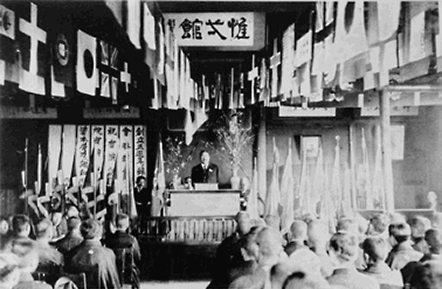 |
 |
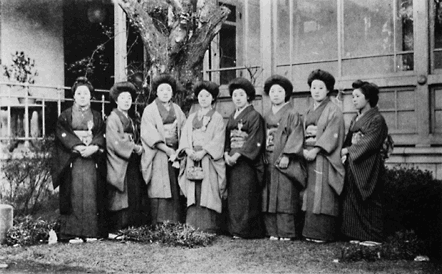 |
 |
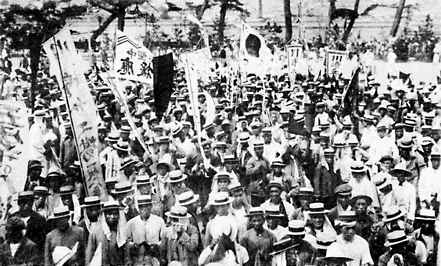 |
 |
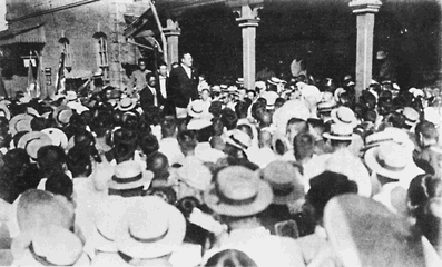 |
 | 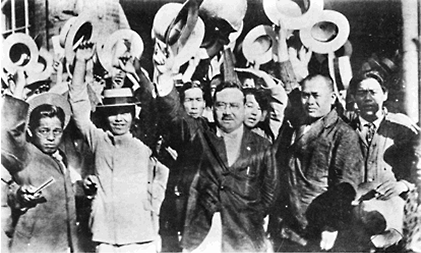 |  |
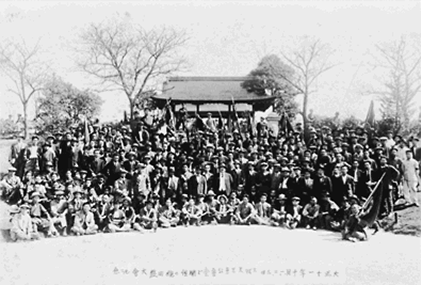 |
 |
 |
 
Charismatic Christian socialist Suzuki Bunji speaking to the fifth annual convention of the Yūaikai (Friendly Society) in 1917. Photos like this were disseminated as postcards throughout the country, helping to establish—for the cost of a stamp—a visual record emphasizing the legitimacy of organized labor.
[S1-01-003]
|
 
The leadership of Yūaikai‘s women’s department posed for this photo at the 1917 convention wearing traditional attire and coiffure.
[S1-01-00]
|
 
The 1921 strike at the Kawasaki-Mitsubishi shipyards was the largest labor dispute of the interwar period, and Sōdōmei celebrated with a commemorative postcard series. Here, strikers display their union affiliation on banners and straw hats, and affirm their patriotism with the Japanese national flag (top, center).
[S1-02-017] |
 
Suzuki Bunji speaking to strikers at the Kawasaki-Mitsubishi
shipyards strike.
[S1-02-017b] |
 
Sōdōmei leaders including Suzuki Bunji (center) at the Kawasaki-Mitsubishi shipyards strike.
[S1-02-017c] |
 
This postcard commemorates the 1922 national convention of the Sōdōmei federation, established the previous year.
[S1-01-006] |
 Previous | Next Previous | Next |
 Previous | Next Previous | Next |
 Previous | Next Previous | Next |
 Previous | Next Previous | Next |
 Previous | Next Previous | Next |
 Previous | Return to start Previous | Return to start |
|
|

|

|
| |
Despite conservative opposition to the emerging alliance between leftwing parties and organized labor, unions were a significant force behind the successful campaign for universal manhood suffrage that culminated in 1925 and extended the vote to every male over the age of twenty.
Whereas the Yūaikai advocated cooperation between labor and management and promoted a moderate policy of mutual assistance and worker education, Sōdōmei soon adopted a more radical and militant agenda emphasizing class struggle. This radicalization reflected the dramatic industrial expansion that took place in Japan in the early 20th century, especially during and after the war boom stimulated by World War I. The factory labor force of male workers in heavy industry grew rapidly. Militant workers challenged the Yūaikai’s policy of conciliation. And the influence of Marxism, Leninism, and Communism following the 1917 Bolshevik revolution in Russia contributed immeasurably to the enhanced attraction of leftwing ideologies (and imagery).
By the mid 1920s, the nationwide labor movement claimed nearly a half million members. In addition to organizing strikes and other protest activities, unions joined other leftists in promoting outreach activities such as youth organizations and cooperative schools. Partly in response to this agitation—and partly spurred by changing production technologies and new theories of labor-management practices—the state and private sector intensified their imposition of hierarchical systems of control. Combined with outright repression, especially after adoption of the Peace Preservation Law in 1925, this turned the late 1920s and early 1930s into a period of intense but increasingly futile labor protest. This confrontation was compounded, of course, by the inexorable march to all-out war that followed Japan’s invasion of Manchuria in 1931.
Sōdōmei carried on until 1940, making it the longest surviving of Japan’s prewar unions. Its durability, however, was facilitated by the increasing takeover of leadership by rightwing elements. Beginning in the mid 1920s, the federation experienced splits and the hiving off of leftist and then moderate member unions. In the 1930s, it was again advocating collaboration with the state and managerial class, which now presided over an economy that was increasingly directed to production for war. In 1940, Sōdōmei and other still existing unions were dissolved and replaced by the ultranationalistic Industrial Association for Serving the Nation (Sangyō Hōkokukai, popularly known as Sampō), which stressed the importance of harmony in labor-capital relations, with particular emphasis on the “family” nature of every enterprise.
Even during the years of intensified government repression that took place after the passage of “peace preservation” legislation in the mid 1920s, however—and even after the invasion of Manchuria—the visual record of the proletarian movement that has been collected in the Ohara archives makes clear that the radical rhetoric and imagery of labor organization and agitation continued to find expression until it was finally snuffed out in the later half of the 1930s.
|
|
|
Labor Movement Posters, 1925-1935
|

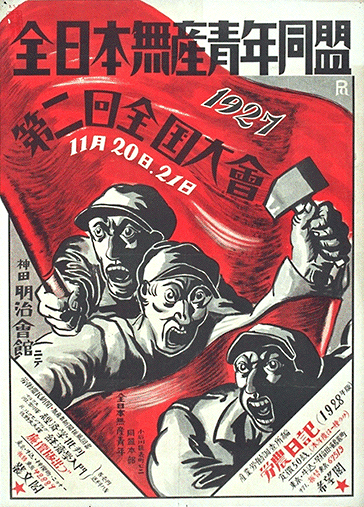 |
 
1927
Three strident workers promote the All-Japan Proletarian Young Men’s Federation’s second national congress in November. One waves the red flag, another raises his hammer. The poster also advertises the Worker-Farmer Diary (Rōnō Nikki), as well as inexpensive translations of Karl Marx and Rosa Luxemburg.
[PA1085]
|
 Previous | Next Previous | Next |
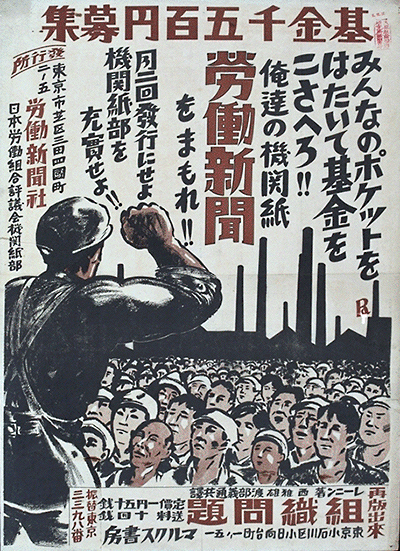 |
 
1927
This poster advertising a “Fund campaign for 1,500 Yen” urges workers to “donate your change” and defend the Labor Press (Rōdō Shimbun). Other exhortations include “Expand our Bulletin Department!” and “Let’s publish twice a month!” The bottom of the poster advertises a new printing of a book by Lenin.
[PA0793]
|
 Previous | Next Previous | Next |
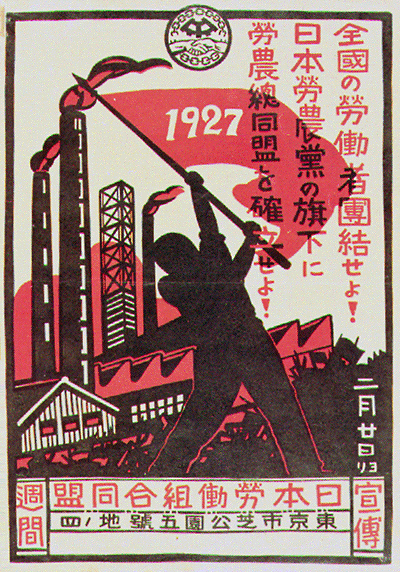 |
 
1927
Sponsored by the Japan Labor Union League (Nihon Rōdō Kumiai Dōmei), this graphic urges workers to organize nationwide and forge a worker-farmer alliance under the flag of the Japan Labor-Farmer Party.
[PA1493]
|
 Previous | Next Previous | Next |
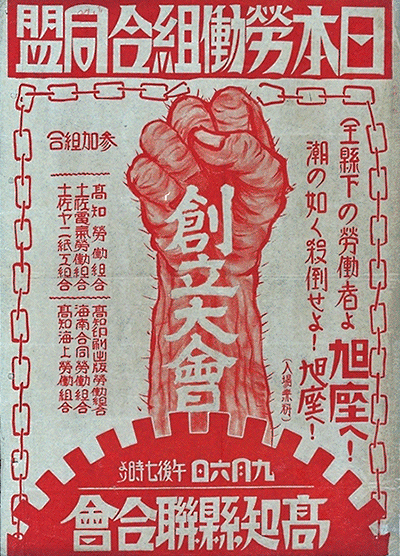 |
 
1929
This bold poster employs typical leftwing iconography: red coloring, industrial gear wheel, and mighty fist of the proletariat breaking the chains of oppression. The text names unions supporting a split from the Sōdōmei federation, and urges “workers from all prefectures to let the surging tide flow.”
[PA0800]
|
 Previous | Next Previous | Next |
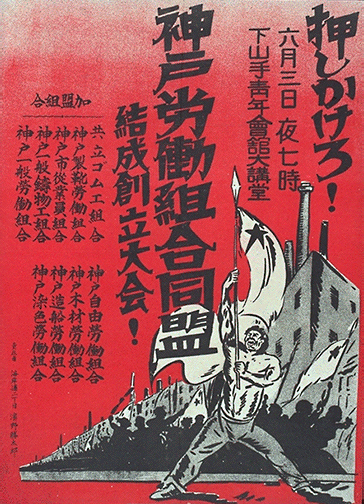 |
 
1932
Under a rallying cry that translates roughly as Come en masse, this poster summons workers to an evening meeting for the formation of the Kobe Labor Union Confederation. The small lettering on the left lists nine sponsoring unions in the Kobe area.
[PA0825]
|
 Previous | Next Previous | Next |
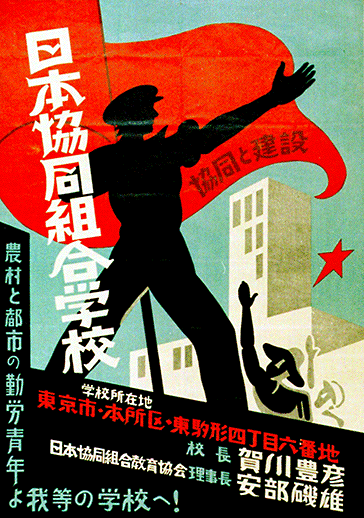 |
 
1935
Worker education was a primary plank in union and leftwing party campaign platforms throughout the interwar era. This poster promotes a Tokyo cooperative school run by Christian pacifists and social reformers Abe Isō and Kagawa Toyohiko. “Young workers from village and city” are urged to come study under the banner of “cooperation and construction.”
[PA0997]
|
 Previous | Return Previous | Return |
|

|

|
| |
Other labor-related graphics from the 1920s and 1930s—both formal and informal in nature—also call attention to the tenacity of radical labor expression well into the 1930s. Japanese workers began celebrating May Day (also known as International Workers’ Day) on May 1, 1920, for example, and continued to do so annually until 1936, when the practice was prohibited.
|
|
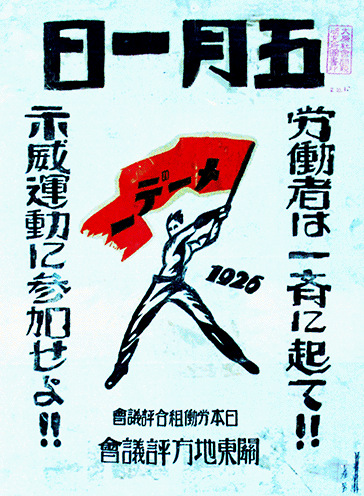
|

1926
[PA2113] |
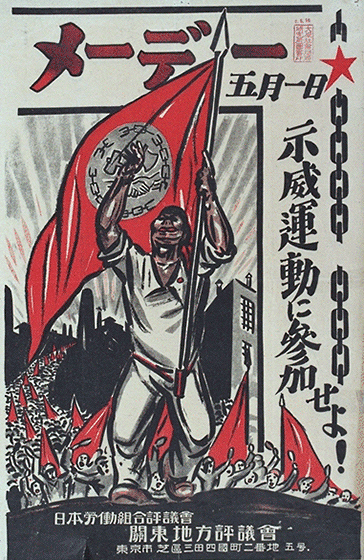
|

1927
[PA0785] |
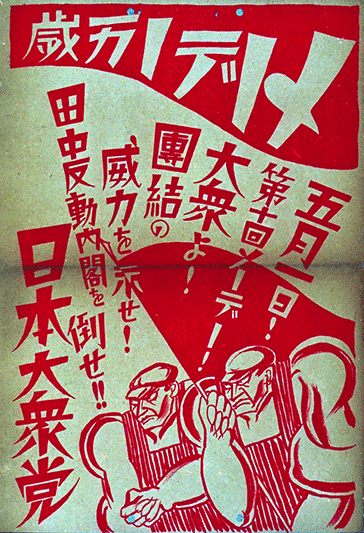
|

1929
[PA2115] |
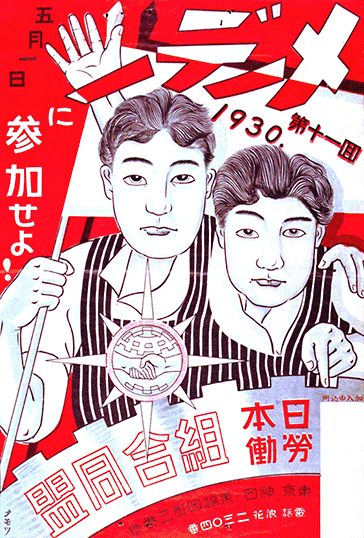
|

1930
[PA2124] |
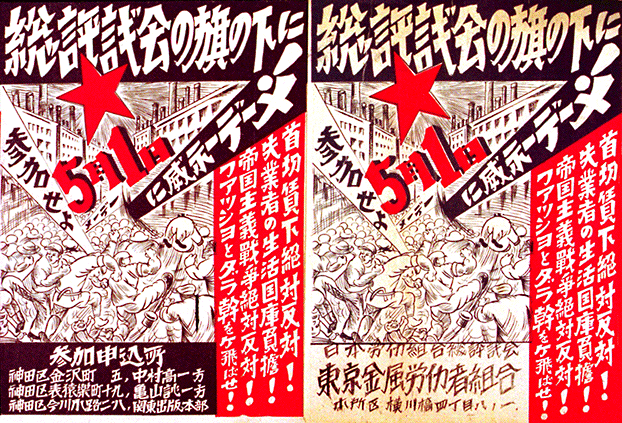 |
1931
[PA2136]
|
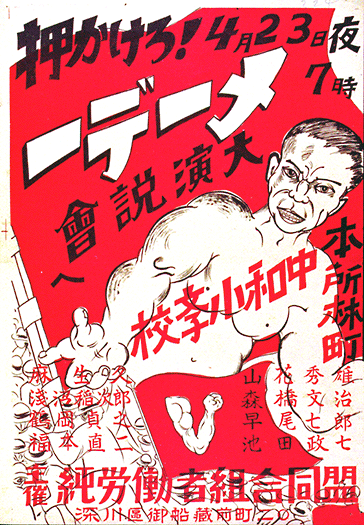
|

1932
[PA2144] |
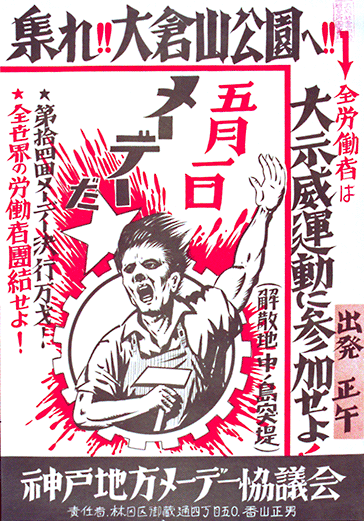 |

1937
[PA2117] |
  Some union activists attempted to defy the government and continue this annual demonstration in support of global worker solidarity even after the ban imposed in 1936. The Ohara collection includes the following white and purple leaflets calling for celebrating the “seventeenth” May Day in 1937. Some union activists attempted to defy the government and continue this annual demonstration in support of global worker solidarity even after the ban imposed in 1936. The Ohara collection includes the following white and purple leaflets calling for celebrating the “seventeenth” May Day in 1937. |
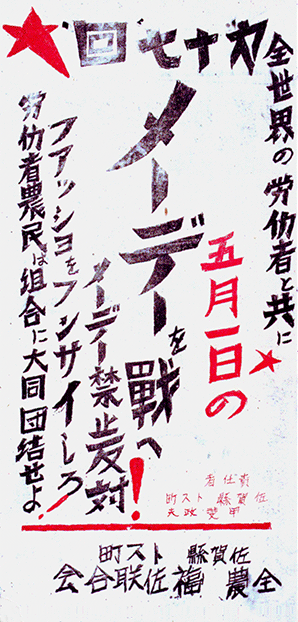 |
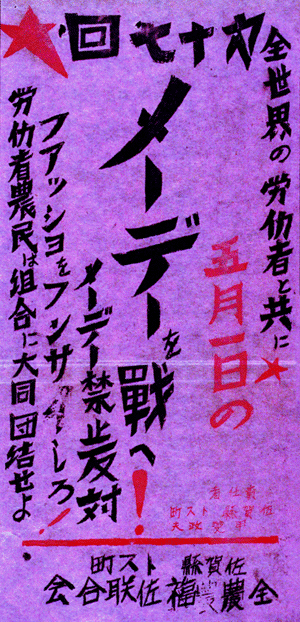 |
1937
[PA2158] [PA2159]
|
| |
As the 1937 May Day leaflets indicate, the more formal poster-style graphics of the labor movement were complemented by a less polished category of exhortatory agitation disseminated in the form of handbills and flyers. Many of these called for participating in or supporting localized protests or disputes. Some were clarion calls for a general strike. These throwaway leaflets reflected handiwork by both fairly sophisticated artists and crude amateurs. The verbiage ranged from terse to wordy, and the visuals—where there were any—were usually harsh and sometimes vicious.
As with the proletarian posters, dissemination of these more informal graphics extended into the mid 1930s. In this respect, they too call attention to the tenacity and diversity of the labor movement even after the heavy hand of the state intruded and organizations like Sōdōmei moved in collaborationist directions. This is not, in fact, entirely surprising when one keeps in mind the persistence of poverty in Depression-era Japan and the considerable variety of labor protests that accompanied this misery. In 1937, for example—the year Japan launched all-out aggression against China—it is estimated that some 2,126 “incidents” of labor protest took place, involving over 213,000 participants.
This is the milieu in which, even as workers were being drafted for war, protest continued to be expressed. Labor unions may have been crumbling, or caving in to pressure, or being won over by patriotic appeals. More than a few protests may have been relatively restrained, or even brief and largely symbolic in nature. In the eyes of the watchdogs of the state, however, these numbers were still alarming. In the dossiers of the thought police, after all, 2,126 disputes in a single year averaged out to almost six a day. Indeed, it was domestic unrest such as this that led the militaristic ideologues to pump up the mythical rhetoric of “one hundred million hearts beating as one.”
|
|
|
“Informal” Leaflets & Handbills
|

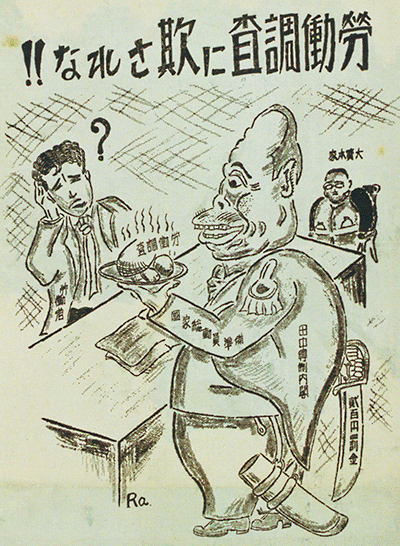 |
 
1927
“Don’t be deceived by the labor survey!” This graphic asserts that the 1927 national labor survey was a loosely disguised tool for the imperial state to determine the minimum wage. In fact, it was that and more: labor surveys were used worldwide to determine the readiness of men for military service.
[PA1527]
|
 Previous | Next Previous | Next |
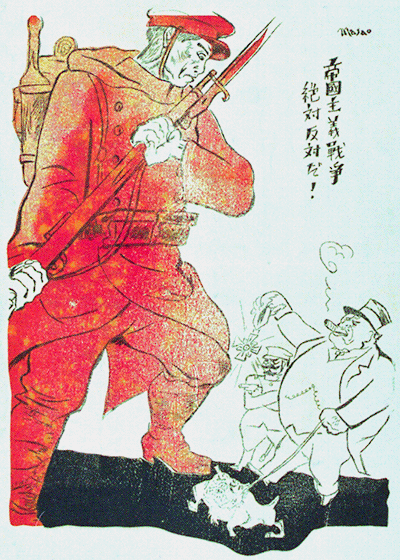
|
 
1928
A giant Japanese soldier stares down at a “fat capitalist” holding a leashed bull dog and dangling a medal from his hand. Behind him a police officer looks on. Censorship laws made opposition to Japanese expansionism a dicey proposition, so the artist obscured the issue; the capitalist could be read as John Bull, a symbol of Great Britain, and taken by censors to indicate opposition to British imperialism.
[PA1525]
|
 Previous | Next Previous | Next |
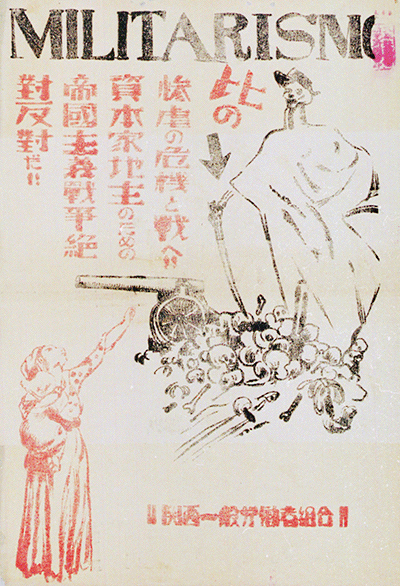 |
 
ca. 1930
This roughly produced flyer, distinctive for both in its use of the Spanish for militarism and its bold anti-military stance, was issued by the Kansai General Workers Union. The Japanese text reads: “Fight against the crisis of this [the pointing arrow] atrocity. Absolute opposition to an imperialist war for the benefit of capitalists and landlords.”
[PA1570]
|
 Previous | Next Previous | Next |
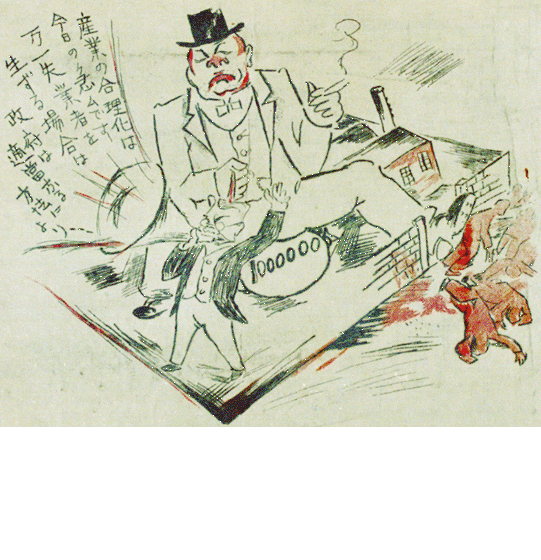 |
 
ca. 1930
This cartoonish flyer portrays a government bureaucrat announcing that industrial rationalization was imperative. But “if this causes unemployment, the government will solve this through suitable action.” The central figure depicts an oversized manager sitting atop a factory with the bloodied bodies of workers lying at his feet.
[PA1528]
|
 Previous | Next Previous | Next |
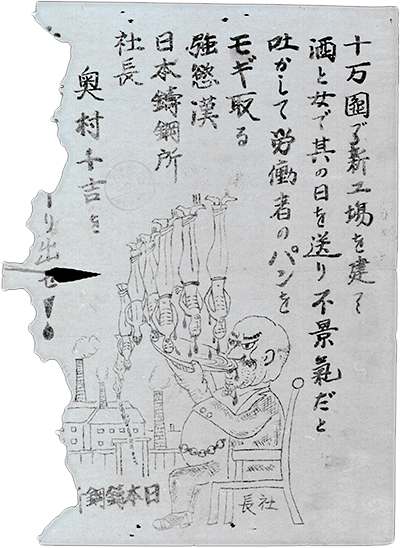 |
 
1930
This grisly flyer depicting a fat capitalist drinking the blood of his emaciated workers is a personal attack on the president of a steel company, both of which are named. The president is described as a greedy, avaricious man who has built an expensive new factory and then snatches bread (pan) from the workers under the name of recession, all the while indulging daily in sake and women.
[PA2007]
|
 Previous | Next Previous | Next |
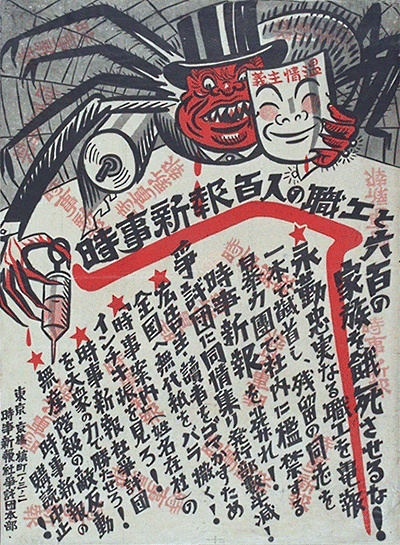 |
 
1931
This broadside attacks the two-faced management of the Jiji Shimpō (Jiji Newspaper), which is accused of firing 100 workers and leaving their families facing starvation. Workers are urged to “bury” the newspaper, which has fired loyal longtime workers with but “a single telegram,” and called in gangsters to intimidate their comrades. The concluding lines of the indictment read: “Stop purchasing and reading the reactionary Jiji Shimpo, the enemy of the proletarian class.”
[PA0854]
|
 Previous | Next Previous | Next |
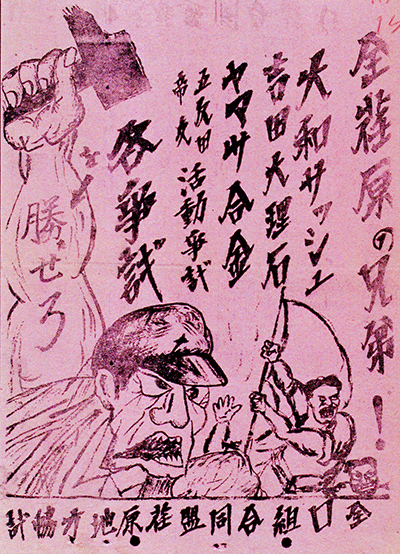 |
 
1931
1931 This appeal to “brothers” in a local struggle calls for “Victory!” in disputes against four different companies. It is provocative to keep in mind that such militant labor activism was taking place in the same year that the Japanese militarists took over Manchuria.
[PA2082]
|
 Previous | Next Previous | Next |
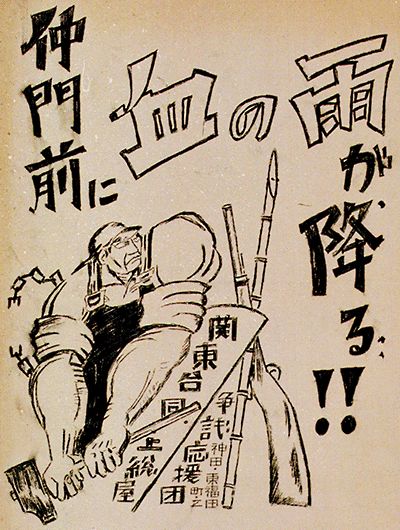 |
 
1932
The terse heading of this militant graphic supporting a strike against a local entrepreneur in the Kanto region declares that “Blood will rain down upon Nakamonmae.” The muscular sledge-hammer-wielding worker has broken his chains, but the meaning of the rifle and sharpened bamboo stave seems ambiguous. Are these signifiers of state oppression? Of worker-farmer militancy? Of both?
[PA1924]
|
 Previous | Next Previous | Next |
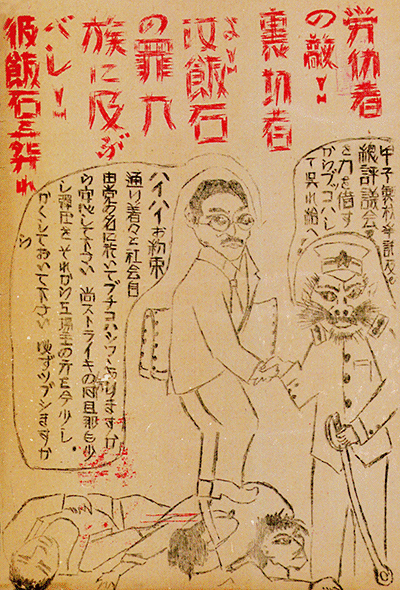 |
 
1932
Disseminated the year after the Manchurian Incident in which the Japanese military seized control of China’s three northern provinces, this crude, cartoon-like, and now opaque graphic is primarily of interest in retrospect for its depiction of a corrupt “traitor and enemy of the working class” (whose name is given) in cahoots with an unsavory sword-bearing police or military officer. The dialogue refers to strike-breaking as well as political factionalism.
[PA1780]
|
 Previous | Return Previous | Return |
|

|

|
| |
The economic dominance of the four largest zaibatsu (Mitsui, Mitsubishi, Sumitomo, and Yasuda) along with the rise of militarist governments in the 1930s closed Japan’s brief moment of “imperial democracy,” and pressed labor unions further to the periphery of the political landscape. This trend was compounded by militarist planning for economic self-sufficiency from the late 1920s, which renewed the state’s emphasis on development of heavy industry. By the late 1930s the government was well into the process of shutting down independent political parties, unions, farmer cooperatives, and even business associations, replacing them with state-controlled organizations created to mobilize the masses in support of military expansion into China. As one consequence, employment patterns began to shift toward an industrial workforce dominated by males. The militarist governments that took Japan into war in the late 1930s provided significant economic stimulus for crucial industrial sectors and created a large cadre of planners, managers, and skilled blue-collar workers that would contribute greatly to postwar reconstruction and recovery. Before that could happen, however, the war came home and destroyed far more industrial capacity than it created.
Japan’s full-scale invasion of China in 1937 launched the nation onto a path that eventually led to its attack on Pearl Harbor and America’s entrance into World War II. Japan’s long march to war seems in retrospect to have been inevitable; yet, the decade was nevertheless witness to union activism at odds with the interests of the emerging militarist state. While the aggregate percentage of workers who belonged to unions did not grow significantly after 1931, the number of workers willing to launch and maintain workplace disputes exploded between 1930 and 1932, and remained steady until 1938. While not a clear indicator of a strong labor movement per se, the number of workplace disputes indicates a persistence of collective action at the social base even in the face of an increasingly repressive state. While the number of long strike actions also indicates employer ability to resist worker activism, it is nonetheless evidence of stronger local unions able to hold out longer in the face of employers who, in law and material resources, held all the cards.
By 1938 political strife and worker unrest had reached the point that militarist factions led by the General Staff of the Imperial Army and Navy who had seized control of the government felt they could no longer tolerate. In 1940 the state outlawed labor unions and political parties, and replaced them with a network of state-sponsored patriotic service organizations. Independent political parties were abolished and all remaining labor unions were folded into the patriotic “sanpō” foundations. Although sanpō was little more than an excuse for the state to legitimize the dissolution of the labor movement while ameliorating very little of the dangerous working conditions, low wages, and managerial abuse faced by Japan’s wartime industrial workforce, some worker representatives nevertheless were able to use traditional styles of nonunion activism—intense negotiation tactics and even strikes—to temporarily buttress what otherwise were rapidly eroding wages and working conditions. The prewar political experiences of Japanese workers prepared them to take advantage of the legal protections granted to them by the Allied Occupation in 1946.
|
|
| |

|
|
|





